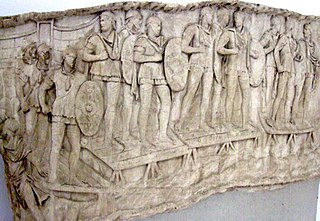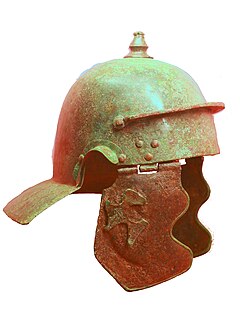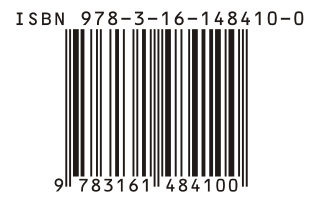
A cohort was a standard tactical military unit of a Roman legion, though the standard changed with time and situation, and was composed of between 360-800 soldiers. A cohort is considered to be the equivalent of a modern military battalion. The cohort replaced the maniple following the reforms attributed to Gaius Marius in 107 BC. Shortly after the military reforms of Marius, each legion formed 10 cohorts. The cohorts were named "first cohort," "second cohort" etc. The first cohort gathered the most experienced legionaries, while the legionaries in the tenth cohort were the least experienced. Until the middle of the third century AD, 10 cohorts made up a Roman legion.

The Auxilia constituted the standing non-citizen corps of the Imperial Roman army during the Principate era (30 BC–284 AD), alongside the citizen legions. By the 2nd century, the Auxilia contained the same number of infantry as the legions and, in addition, provided almost all of the Roman army's cavalry and more specialised troops. The auxilia thus represented three-fifths of Rome's regular land forces at that time. Like their legionary counterparts, auxiliary recruits were mostly volunteers, not conscripts.
Cohors prima Raetorum was a Roman auxiliary infantry regiment. It is named after the Raeti, a designation probably given to some Alpine tribes, which were part of the eponymous province Raetia et Vindelicum, later called simply Raetia. It comprised much of modern Switzerland, western Austria and Germany south of the river Danube. The Raeti originally spoke a non Indo-European language that seems related to Etruscan. However, by the time their territory was annexed by Rome under founder-emperor Augustus, they had become largely Celtic-speaking through contact with neighbouring peoples such as the Vindelici. Finally, during the centuries of Roman rule, they became Latin speakers: their distinctive provincial patois survives today in the form of the Rhaeto-Romance languages.
Cohors quarta Delmatarum was a Roman auxiliary infantry regiment raised in the 1st century AD and continuing to serve into the 2nd century.
Cohors quinta Delmatarum was a Roman auxiliary infantry unit. It is named after the Dalmatae, an Illyrian-speaking tribe that inhabited the Adriatic coastal mountain range of the eponymous Dalmatia. The ancient geographer Strabo describes these mountains as extremely rugged, and the Dalmatae as backward and warlike. He claims that they did not use money long after their neighbours adopted it and that they "made war on the Romans for a long time". He also criticises the Dalmatae, a nation of pastoralists, for turning fertile plains into sheep pasture. Indeed, the name of the tribe itself is believed to mean "shepherds", derived from the Illyrian word delme ("sheep"). The final time this people fought against Rome was in the Illyrian revolt of 6-9 AD. The revolt was started by Dalmatae auxiliary forces and soon spread all over Dalmatia and Pannonia. The resulting war was described by the Roman writer Suetonius as the most difficult faced by Rome since the Punic Wars two centuries earlier. But after the war, the Dalmatae became a loyal and important source of recruits for the Roman army.
Cohors sexta Delmatarum equitata was a Roman auxiliary mixed infantry and cavalry regiment.

The Alpine regiments of the Roman army were those auxiliary units of the army that were originally raised in the Alpine provinces of the Roman Empire: Tres Alpes, Raetia and Noricum. All these regions were inhabited by predominantly Celtic-speaking tribes. They were annexed, or at least occupied, by the emperor Augustus' forces during the period 25–14 BC. The term "Alpine" is used geographically in this context and does not necessarily imply that the regiments in question were specialised in mountain warfare. However, in the Julio-Claudian period, when the regiments were still largely composed of Alpine recruits, it is likely that they were especially adept at mountain operations.

This article concerns the Roman auxiliary regiments of the Principate period originally recruited in the western Alpine regions of the empire. The cohortes Alpinorum came from Tres Alpes, the three small Roman provinces of the western Alps, Alpes Maritimae, Alpes Cottiae and Alpes Graiae. The cohortes Ligurum were originally raised from the Ligures people of Alpes Maritimae and Liguria regio of NW Italia.

The Imperial Roman army are the terrestrial armed forces deployed by the Roman Empire from about 30 BC to 476 AD. This period is sometimes split into the Principate and Dominate (285–476) periods.
Cohors [prima] Bracaraugustanorum [quingenaria] equitata civium Romanorum was a Roman auxiliary regiment containing cavalry contingents. The cohort stationed in Dacia at castra Angustia and castra of Boroșneu Mare.
Cohors [prima] Cananefatium [quingenaria peditata] was a Roman auxiliary infantry regiment. The cohort stationed in Dacia at castra of Tihău.
Cohors [prima] Flavia Commagenorum [quingenaria] equitata sagittaria? was a Roman auxiliary regiment containing cavalry contingents. The cohort stationed in Dacia at castra Acidava, castra Jidava, castra Romula, castra of Sfârleanca, castra of Slăveni and castra of Drajna de Sus.
Cohors [prima] Cretum [quingenaria peditata] sagittaria was a Roman auxiliary archers regiment. The cohort stationed in Dacia at castra Drobeta.
Cohors [prima] Cananefatium [quingenaria peditata] civium Romanorum was a Roman auxiliary infantry regiment. The cohort stationed in Dacia at castra of Bumbești-Jiu (Gară) and Vârtop).
Cohors [prima] Aurelia Antonina Hemesenorum milliaria [peditata] was a Roman auxiliary infantry regiment. The cohort was stationed in Dacia at castra Micia.
Cohors [prima] Flavia Ulpia Hispanorum milliaria equitata civium Romanorum was a Roman auxiliary regiment containing cavalry contingents. The cohort stationed in Dacia at castra of Orheiu Bistriței and castra Napoca.
Cohors [prima] Hispanorum [quingenaria peditata] pia fidelis was a Roman auxiliary infantry regiment. The cohort was stationed in Dacia at castra Largiana.
Cohors [prima] "Augusta Nervia Pacensis" / "Aurelia" / "Flavia Malvensis" Brittonum milliaria [peditata] was a Roman auxiliary infantry cohort. The cohort stationed in Dacia at castra Buridava, castra of Bumbești-Jiu (Gară) and Vârtop) and castra Malva.
Cohors prima Ulpia Dacorum was an infantry regiment of the Auxilia corps of the Imperial Roman army. It was founded by the Roman emperor Trajan, probably in preparation for his planned war against Parthia (113-6). The regiment's honorific title Ulpia refers to the emperor's gens, or clan-name.






